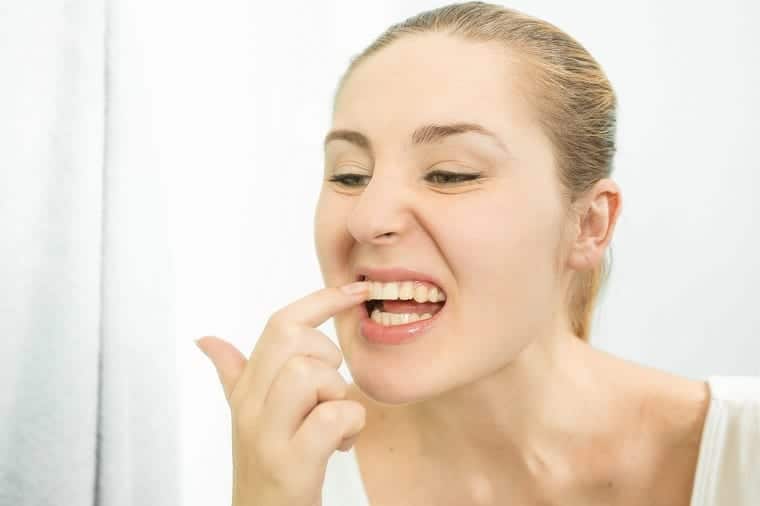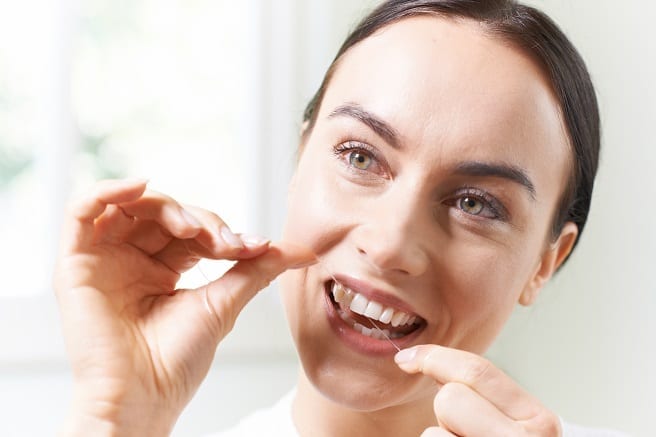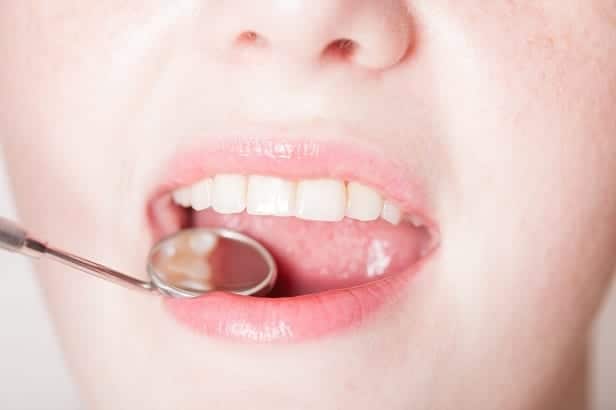Pyorrhea, more popularly known as periodontitis, is one of the most widespread dental conditions for humans. This type of dental sickness occurs when the periodontium tissues that surround and support your teeth become compromised. When left untreated, pyorrhea can lead to you lose teeth or outright ending up losing teeth when push comes to shove. Tooth loss happens because you start losing the alveolar bone surrounding the teeth as your periodontium deteriorates.
It’s also important to note that before you get full-blown pyorrhea, you first end up with gingivitis and it gets worse from there. Once you have symptoms of this gum condition, you should treat it to avoid it worsening to periodontitis or some other form of periodontal disease.
Page Contents
Signs and Symptoms of Pyorrhea
There are no symptoms to pyorrhea in its initial stages. However, keep in mind that you’re already at risk if you have bad dental hygiene habits or tend to neglect your teeth cleanliness.
As the disease progresses from gingivitis, it starts showing major signs and symptoms you should pay attention to, such as the following.
- Bad breath
- Loose teeth
- Painful chewing
- Swollen or puffy gums
- Gums that bleed easily
- Bad breath or halitosis
- Recurrent gum swelling
- Pus between your teeth and gums
- Bright red, dusky red or purplish gums
- New spaces developing between your teeth
- Gums that feel tender or sensitive when touched
- A change in the way your teeth fit together when you bite
- Tooth or gum redness or bleeding when flossing or brushing
- Blood when you bite into hard fruits like pears, apples, or guava
- Deep pockets or spaces formed between the gums and the teeth
- Loose teeth that move in place when you touch it with your finger or tongue
- Gums that pull away from your teeth (recede), making your teeth look longer than normal
If these symptoms were to persist then you should consult your dentist or doctor ASAP. The more you ignore pyorrhea and allow it to progress the likelier you’ll get its most notable symptom, with is outright tooth loss.
Causes of Pyorrhea

Pyorrhea typically happens when you lack dental hygiene. It can also be hereditary in the case of aggressive pyorrhea or caused being immunocompromised, as in the case of cancer or HIV patients. Letting bacteria stick to your teeth in the form of filmy plaque or tartar will deteriorate your teeth from its enamel to its periodontium tissues.
At any rate, here are the most common causes of pyorrhea:
- Poor Dental Hygiene: Bacteria tend to spread if you don’t kill them with mouthwash that kills 99.9 percent of them or brush your teeth clean off all plaque and food bits. Flossing also helps a lot in scraping the plaque and the remnants of rotting food in between the spaces of your teeth. If you don’t brush and floss twice daily and mouthwash occasionally, you’re in for a rude awakening.
- Complacency and Neglect: Complacency is a slow but sure killer in and of itself. When you’re complacent with your dental habits to the point where the coating of plaque on your teeth has become tartar or seemingly enamel (it’s not, by the way), then that leads to dental destruction of the highest order. You don’t realize how neglect can affect your teeth and gums until it’s usually too late.
- Plaque and Tartar: When bad oral bacteria are allowed to run rampant in your mouth, they tend to form off-white or yellow film of protein and leftover food that’s teeming with germs called plaque. When this plaque hardens due to calcium deposits being put in the mix, it turns into calculus or tartar. The longer plaque stays on tooth enamel, the worse off your teeth and periodontium will become down the line.
- Periodontal Destruction: The disease is caused by the destruction of the periodontium tissue or the supportive tissue that keeps the teeth anchored to the gums and jawbone. Improper dental hygiene is what kills this tissue since that allows bacteria and their acidic waste products to proliferate. Bacterial populations should be kept low by ridding your mouth of leftover food, starch, and sugar and washing it with antiseptic mouthwash.
- Gingivitis or Mild Periodontal Disease: Great things start from small beginnings. Bad things too. Plaque left on your teeth can cause gingivitis, which is the mildest form of periodontal disease. This condition is defined as inflammation and irritation of the gum around the base of your teeth, which is also known as the gingiva. Gingivitis is reversible with good home oral care and professional dental treatment, as with periodontitis.
- Periodontitis or Severe Periodontal Disease: By failing to reverse gingivitis, it can worsen and develop all the way into pyorrhea or periodontitis. In other words, gingivitis can directly result into periodontitis, which causes pockets to develop between teeth and gums as your periodontium tissues die out. These pockets where the periodontium and gingiva used to be will then be filled with plaque, tartar, and (of course) bacteria.
- Diabetes and Pyorrhea: Certain conditions can cause other conditions to surface in your body. This is the case with diabetes and pyorrhea. If you have diabetes, your chances of also developing periodontitis also increase. Diabetics are often asked to observe dental hygiene to save themselves from further complications like dental disease.
- Smoking: Smoking tobacco is bad for you in many ways, including its impact on your dental health. Yes, there are links between smoking cigarettes and pyorrhea development. Continuing to smoke while your periodontitis is being treated also interferes with the treatment so you better get a nicotine patch and wean yourself from smoking altogether.
Types of Pyorrhea
Pyorrhea or periodontitis come in several variations or types. The thing they have in common is the fact that having them usually leads to bacteria eating away at your periodontium to the point where your teeth loses its anchors to your jaw, making it easier for them to loosen and fall off.
The most common types of pyorrhea include the following.
- Chronic Pyorrhea: The most common type of pyorrhea is the chronic kind. It affects mostly adults but it’s not unusual for children to suffer from this either. This condition is caused by plaque buildup that includes slow periodontal, gum, and bone deterioration that might get worse or improve over time depending on what the patient does about it.
- Aggressive Pyorrhea: Aggressive periodontitis typically starts at early adulthood or childhood and affects only a select number of the population. It’s a hereditary type of periodontal disease that affects families for the most part. If left untreated, this destructive pyorrhea type will cause rapid progression of tooth and bone loss when push comes to shove. It should be dealt with ASAP.
- Necrotizing Pyorrhea: Necrotizing periodontitis or periodontal disease is the worst type of pyorrhea that involves the death of supporting bone, tooth ligaments, and gum tissue caused by necrosis or lack of blood supply. This then results in severe infection. This condition usually occurs in people who have a suppressed immune system such as from cancer treatment, HIV infection, and so forth. It’s also caused by malnutrition.
Treatment of Pyorrhea

Periodontal disease or pyorrhea is curable but there is a point of no return you should be aware of with this disease. You might not be able to save some or all of your teeth if your pyorrhea is particularly bad, despite it being curable or reversible.
Long story short, you should brush and floss daily as well as gargle with mouthwash in order to keep bacterial populations low and your pyorrhea risk even lower. Here are important things to remember:
- Brushing: You should brush twice a day or even three times a day to avoid developing pyorrhea or any other kind of oral disease. You should also brush properly and don’t scrape too hard with your brush. Move the brush in a circular pattern and do it thoroughly but gently instead of roughly and shoddily. Brush at least 2-3 minutes daily and don’t forget to regularly change your toothbrush as well every 3-4 months.
- Flossing: Kids nowadays know flossing as a dance but these Millennials and Gen Z children should also be aware of how to properly floss in the dental sense. Many simply slip the floss between the teeth then pull it out in mere seconds, thinking they’re done. What they’re supposed to do is use a piece of floss on each individual tooth and then scrape not only the stuck bits of food but also the plaque on the tooth surface until all the teeth have been properly flossed.
- Mouthwash: Mouthwash is at least a bit more self-explanatory than flossing or brushing. Just gargle with the mouthwash and then spit it out, right? In certain situations, like when you have a bacterial infection or swelling infected gums, you might need to let that mouthwash stay in your mouth for at least 30 seconds before spitting it out. Ideally, you should use antiseptic mouthwash and use it after brushing and flossing. It also helps get rid of bad breath.
- Home-Made Remedies: You can also make use of home-made remedies to help fight or prevent pyorrhea. For example, you can chew an onion in order to kill germs that assist in periodontitis development. Onion also helps treat the bleeding gums symptom of both gingivitis and periodontal disease. You even have the option to eat fruits enriched with Vitamin C such as lemon and guava. Lemon prevents gum inflammation as well.
- Dentist Visit: You should regularly visit your dentist. This is important because he’s the one who’ll keep tabs on the healthiness of your gums. He can also do thorough cleaning of your teeth and gums that are even more effective than everyday brushing and flossing known as prophylaxis for at least every 6 months. Your dentist knows best and can provide the right treatment for your issues.
- Deep Cleaning: If you’re a patient with advanced pyorrhea and deep periodontal pockets where there used to be gum tissue, bone, and ligaments, you should avail of this treatment. It’s a package deal to treat chronic gum disease using the services of scaling and root planning.
- Scaling: This procedure involves the dentist removing tartar and plaque on your teeth, gums, and periodontal pockets. This buildup of yellowish and brownish material is directly causing your pyorrhea. Special debridement tools are needed to access these areas because they’re beyond the reach of flossing, tooth brushing, or prophylaxis treatments.
- Root Planing: The infected root is then smoothened out using dental instruments like a drill or a laser. The bacteria usually collects at the root and the pockets caused by your receding gumline, thus necessitating cleanup and removal. What’s more, infected tooth roots need to be planed in order to begin their healing.
- Aftercare: Your dentist will likely prescribe an over-the-counter (OTC) painkiller and antibiotic for your infection. He might also recommend follow-up visits to determine whether or not your deep-cleaned teeth require more scaling and root planning. These additional appointments also help him check the progress of your gingival and dental healing.

- Periodontal disease, like dental caries or tooth decay, is caused by neglect and not maintaining proper dental hygiene for the most part. Your food intake as well as whether you smoke and drink are also contributing factors. Therefore, observe proper dental hygiene and visit your dentist regularly. Keep him updated with your dental condition and what treatments you might need to prevent this sickness from happening or progressing.If left untreated, pyorrhea can cause a lot of bone and tissue damage, to the point where you’ll outright lose teeth. You might end up having no choice but to wear dentures or get an expensive dental implant operation. Your immune system can also get quite strained when dealing with a chronic type of inflammation or infection, leading to extra complications if you’re not careful.It’s also common sense to observe dental hygiene on top of getting periodontitis treatment from your dental professional because as always, an ounce of prevention will always trump a pound of cure.Thantakit International Dental Center is Thailand’s longest established dental center. Situated in Bangkok, our clinic is renowned across the world as a destination for world-class dentistry, with most of our patients flying to us from Australia.Please contact us today to get a FREE dental consultation.












